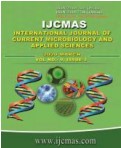


 National Academy of Agricultural Sciences (NAAS)
National Academy of Agricultural Sciences (NAAS)

|
PRINT ISSN : 2319-7692
Online ISSN : 2319-7706 Issues : 12 per year Publisher : Excellent Publishers Email : editorijcmas@gmail.com / submit@ijcmas.com Editor-in-chief: Dr.M.Prakash Index Copernicus ICV 2018: 95.39 NAAS RATING 2020: 5.38 |
During the present investigation yellow vein mosaic disease in bhendi (Abelmoschus esculentus (L.) Moench) caused by a whitefly Bemisia tabaci (Gennadius) (Hemiptera: Aleyrodidae) transmitted Begomovirus particularly Bhendi yellow vein mosaic virus [IN-NVS-2018] or BYMV [IN-NVS-2018] or BYMV was characterized by symptoms of homogenous interwoven network of yellow veins enclosing islands of green tissues. In extreme cases, the infected leaf becomes totally light yellow or cream colored. The fruits of the infected plants exhibit pale yellow color, become deformed, small and tough in texture. Modification of the Doyle and Doyle (1987) method for the DNA extraction in which instead of 750µl each CTAB buffer and Chloroform: Isoamyl Alcohol (1:24), 1000µl each pre-heated CTAB extraction buffer Chloroform: Isoamyl Alcohol (1:24) was used for the proper precipitation of proteins and carbohydrates and yielded good quality of DNA. The presence of BYMV was detected from all the part tested viz., tip of the stem, tip of the root, flower bud, fruit, petel, sepal, ovary, pollen, seed coat, cotyledon and embryonic axis. Results indicated that the virus is present in all the parts of the plants including, vegetative and reproductive parts of the flowers as well as in seeds. However, in grow out test, none of the sample showed symptoms on the seedling. Therefore, it can be concluded that the virus is present in the seed, however, is not seed transmitted. From the best of our knowledge, this is the first report in the world which sowed the presence of BYVMV in bhindi seeds.
 |
 |
 |
 |
 |